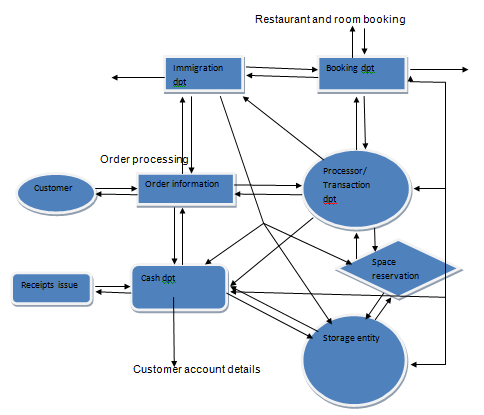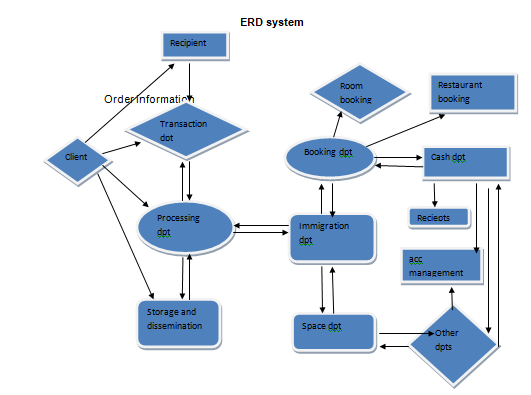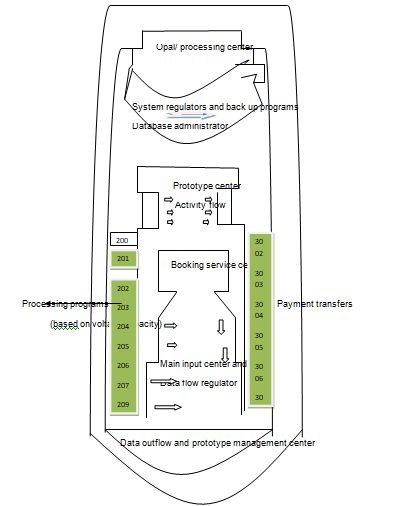Introduction
Data flow diagram (DFD) and other information enabled processing systems are vital components that aid transmission of information in various institutions. They are performance oriented systems that any institution with strong aspirations to recording high growth levels and competitive advantage should integrate.
This is because the systems play a critical role in ensuring effective data management and flow from one center of operation to another. Indeed, DFD remains a vital graphical representation that shows how information flows through an information system.
It gives a clear channel through which data can be transferred in an organization to ensure accountability and efficiency. That is the system enables one to identify key information centers that are used to facilitate the acquisition and dissemination of data. It also aids coordination of activities between various departments and business units that result to high returns.
Consequently, the system enables its users to understand the existing business processes and data transfer procedures. This helps in identification of possible strengths and weak areas that may require integration for effective service delivery (Rosenblatt & Shelly, 2012, p, 2).
The system also enables users to look and monitor how data flows through a system. This is evident since it is concerned with key things that appertain to information management such as where data is being generated from, where it is processed and the storage center.
The process fosters proper assessment and management of data received by ensuring the integrity of the acquired information. As noted, this system will best suit Afloat Company that seeks to revolutionize its operations with an aim of providing consumer oriented and quality services to clients.
The company that operates in the transport industry seeks to implement a state of the art IT system to help in enhancing delivery of cruise services. The company is keen to offering best solutions and services that exceeds consumer’s expectations in various units of operation.
Data flow diagram DFD new design
The new data flow design is to enable the company to manage the vast amount of information that it captures and stores effectively. It will provide requisite incentives that will facilitate the development of effective data administration centers.
These centers will foster data sharing between various departments in the company (Kozar, 1997, p, 1). This is vital since effective data transmission in a company that provides such crucial transportation services is inevitably sound. The new system will provide a proper link between key stakeholders in the institution such as clients, employees and the management.
The link will create a favorable operating field that is necessary for business growth and the realization of quality performance. In particular, it will ensure that the cruise liner service provider company has a well established booking process for restaurants and room services.
It will also facilitate effective client account management, room to room communication, onboard photography, immigration and customs processing (Reynolds & Stair, 2010, p, 518).
Further, the system will facilitate cashless shopping in souvenir, space reservation for activities, internet coordination and event booking for shows. This explains why the system is of great significance to all stakeholders in the company whose objective is to achieve the best results out of the company’s operations.
That is managers intention is to ensure delivery of quality services that would enable them to attract more consumers and make high returns. However, clients expect to achieve quality, timely and customized items or services that match their expectations and satisfy their needs promptly.
The new system envisages to addressing key issues that appertains to data management that has threatened to stall operations in the institution.
These issues include database integrity, network configurations, storage of data, updating of information and issues relating to hardware selection. Other issues that the system seeks to address entail data security considerations, information feedback, integrity, back up considerations and the implementation strategy (Reynolds & Stair, 2010, p, 520).
These are vital issues that any organization that seeks to record exemplary performance must address. That is institutions such as Afloat Company must ensure effective acquisition, processing, storage and dissemination of data.
This is essential in upholding data integrity that enables clients to build confidence on an institutions capacity to maintain their information. This will enable the group to attract more travelers who would be able to disclose information pertaining to their locations without reservations.
It will also enable Afloat Company to configure its systems appropriately to facilitate efficient and effective response to clients’ issues or requests (Kozar, 1997, p, 1).
This will enhance the execution of key procedures such as automation booking of rooms, hotel services, vehicles and payment delivery that requires absolute accuracy. Indeed, the group’s clients are bound to receive immense benefits if the system is fully integrated as shown below. It is set to give clear flow of information and execution of travelling activities. The arrows points at the direction of information flow.

How it works and the information that is processed
The diagram provides clear channels on how information and activities are to be managed in the institution. This will foster timely delivery of services to customers. It focuses in making booking services, data storage and update more efficient.
In particular, the data flow diagram has a central processing center where data that is captured or acquired is fed for processing. Data processed will then be channeled for storage and subsequently disseminated through the designated channels company (Kozar, 1997, p, 1).
The information that will be processed as acquired from clients includes their payment details, location, travelling destination, name and type of service sought. Other information include cashless on board duty free, space reservation activities, client account management and immigration details.
As indicated, the information will flow from the client, to the recipient who will then forward the received data for processing. This will be followed by dissemination of the data to respective service departments to aid timely delivery of services.
For instance, the information will flow from the main center to booking department that will then serve other subsidiary units that include cash, immigration, communication and immigration departments (Sharp, 2001, p, 51).
This shows clearly, how well the program will aid feedback process and data management system that is vital in any organization for timely response to emerging issues that may impede operations. Variably, the system holds effective data storage system, quality processors, well configured networks, security protocols and quality infrastructure. It is important to note that the system holds effective back up p
Entity Relationship Diagram (ERD)
As noted, an entity relationship diagram (ERD) is a model that gives a clear description of a database system. It enables system developers and users to understand the relationship that exist between various information channels or data centers (Dafoulas & Ward, 2006, p, 9). The model also facilitates the understanding of how data is shared in an institution to ensure effective service delivery.
That is it gives a guideline of how various entities are related within a database system and their operating capacity. The model has been instrumental in most settings with various managers indicating that its integration is vital in ensuring proper execution of data flow activities. This explains why the model is significant for Afloat group that seeks to integrate a new data processing system.
In particular, the model will enable the management of the group to understand how the new design works and how key entities are related. It will enable them to understand how the configuration process was executed and its viability. This is critical since understanding of the configuration and data processing technique enhances the credibility of a system that uses UTS online programs.
Evidently, ERD model will ensure proper transmission of information and sharing of data between various departments in the institution. This will facilitate quality service delivery by the institution that focuses its synergy in the provision of critical cruise liner services that require proper coordination and management (Dafoulas & Ward, 2006, p, 9).
This is essential especially in the transportation sector that requires holistic revolution by adopting conventional service delivery techniques. The conventional techniques should be integrated to ensure timely delivery of key services to clients such as booking, payment systems, immigration processes and data storage (Singh, 2009, p, 262).
This is to build confidence on system users and clients who expect quality services. ERD model that is set to provide essential incentives for data management in the company is shown below.

The model shows how information is shared between various entities within the system flow diagram. Its aim is to enable system users to establish how data relating to various activities are acquired, processed, stored and disseminated through various information centers.
Since the company is a cruise liner corporation that provides transportation services, key data that will pass through the system for processing include client name, destination, immigration details and booking information (Dafoulas & Ward, 2006, p, 16).
Information pertaining to client account management, cashless shopping services, room to room communication and internet services also form key data that is set to pass through the new model. The information will flow from respective clients or source centers to the recipient center for sorting. Then the data will be forwarded for processing at the processing center where dissemination will take place after completion.
The dissemination of information will be executed through respective support centers. For instance, information relating to service booking will be channeled through the booking department. The information will equally be shared between cash department, space reservation and immigration information centers as shown.
This is vital in ensuring proper tracking of activities, effective utilization of resources and the provision of timely services to clients. Consequently, payment information that includes receipting, and invoicing details will be channeled through cash center.
The information will equally be distributed to other service centers to aid accountability (Singh, 2009, p, 263). The processed data will be stored under quality ideals and effective control protocols to guarantee their integrity.
This is evident since the system provides a centralized data storage center that is integrated with proper security controls to avert unauthorized access of data. This is essential since data storage and update that the system seeks to correct have presented immense challenges that have been affecting operations in the company.
Although the system seeks to adopt UTS online support system to aid its functionality, it will not provide holistic solution to all the complications that clients face in the company. This is because the online system provides integrated services that may not facilitate effective user understanding on how key entities are related.
This may impede decision making and formulation of various operating strategies during and after the implementation process of the model. The system will out rightly spearhead or enhance individuals understanding on the various data that is relayed or shared between the entities.
That is the system provides clear direction and flow of data to respective information centers to aid the provision of services to clients. UTS support system also enhances the models back up capacity. It provides effective software with a high processing power and big storage space and data reserve program that ensures data safety.
This is vital since data back up systems enable easy retrieval or acquisition of the same type of information incases where crucial data is lost due to various reasons (Singh, 2009, p, 268). Consequently, the support system facilitates network configuration that ease the understanding on how the entities are interrelated. The model is integrated with quality control measures
Business Brief and Conceptual Design
Business Brief and Conceptual Design are integral models that create room or allow for effective and formal communication between key stakeholders who participate in system development. The models especially conceptual design facilitates mutual communication and understanding between system designers and clients with an aim of developing an acceptable system.
That is they facilitate the development of systems that hold the capacity to serving clients needs and expectations with limited complications (Phillips, 2004, p, 3). Indeed, business brief is a written document that contains project design features and structure. Its main purpose is to provide credible information and structural designs that focuses on achieving the intended results of a system.
Consequently, conceptual design focuses in identifying business opportunities and development of viable project scope to aid the achievement of identified needs of clients. It also allows for automated and formal communication between stakeholders in institutions. This aims at finding innovative and automated solutions to the evident complications that affects system functionality (Phillips, 2004, p, 5).
In review of these, the design systems provide pertinent incentives that would help in facilitating holistic integration of the new data flow system in Afloat company. This is evident as the design systems main objectives are to ensure that a program is able to achieve its intended goals.
That is the design protocols provide basic incentives that aids structural adjustments and implementation of quality design features especially at the Opal center. The protocols also focuses on identifying business opportunities and effective structural designs that holds the capacity of enhancing transmission of data from one center to another using UTS protocol.
Certainly, the designs will enhance sharing of information between various entities as shown in the DFD and ERD systems (Dicerto, 1998, p, 2). They will ensure that there is sufficient and smooth flow of information to various levels of operations.
This will enable managers and other officials in Afloat Company to execute their coordination activities with immense ease. The management of the institution will not record severe complications that they have facing in terms of client booking, payment, and customs processing again.
In particular, the company’s management will use the business brief documents to explain to the clients how the new system works and the solutions that it provides. They will also use the brief document to highlight to system users the key control protocols, safety measures and functionality of the new system.
Consequently, they will use it to highlight the kind of solutions that the system can facilitate or pertinent services that it offers (Phillips, 2004, p, 9). This is essential in ensuring that the new system is utilized effectively and that every program is used appropriately.
It is important to note that, the system is divided into various entities or information centers that receive processed data. The information flow channels must be well understood and monitored to enable system users to get timely assistance. Understanding of these data flow channels requires proper induction and mentoring of clients through brief documents.
This will enable them to know what is expected of them and their contribution in ensuring absolute achievement of the intended objectives of the system (Rosenblatt & Shelly, 2012, p, 3).
Variably, conceptual design will enable managers in the institution to relay the opportunities that the new system presents and its scope of operation. This will aid the understanding of key services that the system will support to ensure its correct usage.
This is vital since the system is designed with specific tasks, task centers, prototypes and information processors that are delicate. It is also designed to aid transfer or distribution of information to diverse entities. These task and information centers include booking, payment, room to room communication, client account management, immigration, customs and payment departments (Dicerto, 1998, p, 3).
Understanding of how information is flowing in these departments is crucial since one can only get pertinent information from a relevant department. This is apparent since processed data is transmitted to respective data centers and then shared appropriately. This is shown in the business brief and conceptual diagram shown below.

Conclusion
Indeed, effective flow of information between key entities is bound to present a major boost in service delivery in the company. Firstly, it will enable the company to expand its customer base since high level of efficiency will attract more clients.
This is because most clients in the transportation sector prefer dealing with corporations that have well functioning automated systems that facilitates booking and payment services.
Variably, the two designs provide necessary support programs that facilitates proper configuration of internal data communication system. This is also crucial since the realization of effective flow of information is dependent on how the configuration is done.
List of References
Dafoulas, G & Ward, P 2006, Database Management Systems, Thomson, London.
Dicerto, J 1998, Planning and Preparing Data-Flow Diagrams, Hayden Book Co, New York.
Kozar, A 1997, The Technique of Data Flow Diagramming. Web.
Phillips, P 2004, Creating thePperfect Design Brief: how to Manage Design for Strategic Advantage, Allworth Press, New York.
Rosenblatt, H & Shelly, G 2012, Systems Analysis and Design, Course Technology Cengage Learning, Boston.
Reynolds, W & Stair, M 2010, Principles of Information Systems: a Managerial Approach, Course Technology, Cengage Learning, Boston.
Sharp, A 2001, Data Flow Computing Theory and Practice, Ablex publ, Norwood (NJ).
Singh, K 2009, Database Systems Concepts, Design and Applications, Prentice Hall, E Rutherford.